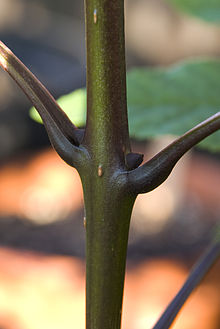Sleeping bud
Dormant buds or sleeping eyes , in botany as Proventiv bud (of proventiv = coming forth) refers to originate at a young stage of the point in question, for. B. branch or trunk, of a plant . They sit under the bark and are barely or not at all recognizable. There they can remain viable for years and even decades. Their sole task is to restore lost organs (branches, twigs or even the entire trunk). A growth , the plant mass are excited by cutting off large parts.
Plant of dormant buds
At the same time as a bud from which a leaf develops, one or more secondary buds are always formed. These buds stop their development and behave in a rigidity or dormancy until a situation arises that makes it necessary to sprout this previously dormant bud. Typically, these buds form in the leaf axilla, i.e. the angle that the upper side of the leaf (or upper side of the petiole) and the stem axis enclose. Vegetative side shoots (axillary shoots) or flowers or inflorescences ("axillary shoots ") can emerge from these buds .
Localization of sleeping eyes
After the leaf has been shed and the stem axis has grown in thickness over several years, the leaf knot , i.e. the former axilla and the bud located there, is no longer readily recognizable, and the side shoots that develop at this point seem to come directly from any point on the bark arise from.
See also: adventitious formation , stick rash
Individual evidence
- ↑ Ulrich Lüttge, Manfred Kluge, Gabriela Bauer: Botany: A basic empty book, VCH Weinheim 1988, page 376


